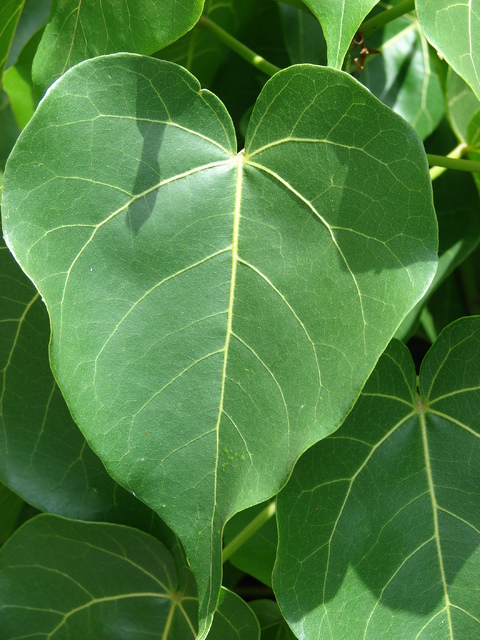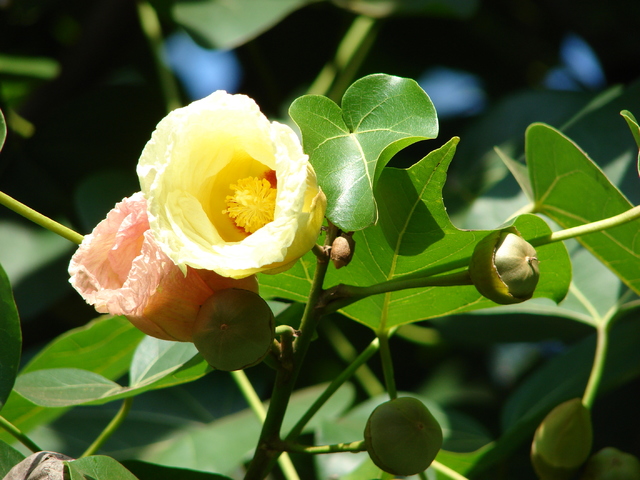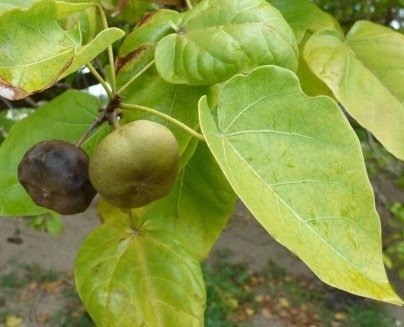Milo: The ideal tree for lower elevation landscapes
The home of King Kamehameha I in Waikiki was surrounded by milo trees. The king had many reasons to favor the tree. It was considered sacred by early Polynesians. Its wood was prized for making beautiful bowls and carvings. The bark was used for cordage and the fruit was used to make dyes. The leaves and flowers could even be eaten if tastier food was not available. Milo trees also provided deep shade on hot summer days.
The tree continues to be valuable for its provision of shade and use as an attractive street tree or landscape specimen. It is also still a popular source of wood for carving. Today, it is often used as a landscape specimen plant and can also serve as a windbreak or shield from salt spray where needed.
Milo (Thespesia populnea) is a member of the large Malvaceae (Mallow) family that includes about 100 genera and more than 2,000 species including abutilon, cotton and hibiscus. It is a very close relative of another Hawaiian heritage plant the hau tree. Hibiscus tiliaceus has similar leaves and flowers but differs slightly in its growth habit. Both trees are well suited to coastal locations with slightly alkaline soil that drains well.
Milo’s generic name Thespesia is derived from the Greek word thespesios which means divine. This refers to the sacred milo plants that were collected in Tahiti in 1769 by Capt. James Cook. The species name populnea translates to poplar-like, probably referring to the leaf shape that resembles poplar leaves. The Hawaiian name milo means to twist, curl or spin and may be a reference to the tree’s growth habit, especially in windy locations at the seaside.
Though it is known that milo was brought to Hawaii by early Polynesian settlers, it is also possible that it was already growing in the islands. Milo trees grow throughout the Pacific islands and are prolific seed producers. Dry milo seeds can float on salt water for a month or more and still be viable. It is quite possible that seeds made their way here by floating on the ocean before the settlers arrived.
An ideal specimen plant for gardens at lower elevations, milo trees often remain shorter than 20 feet tall and have lovely dark green, heart-shaped leaves with lighter colored veins. Their attractive yellow flowers resemble hibiscus flowers in shape. The 2 to 3 inch long flowers open early in the day as pale yellow with a deep burgundy center. As the day progresses, the color gradually changes to a shade of pink or darker purple. The tree flowers nearly year-round and produces a small, round fruit following flowering. The fruit usually dries on the tree to a woody seed capsule, which drops to the ground, spilling its seeds. The numerous seeds germinate easily causing the plant to be considered invasive in some locations.
Though milo can be propagated asexually from cuttings or by air layering, seeding is easy and usually the preferred method. No special treatment is required for milo seeds to germinate. Soaking in cool water overnight can hasten germination somewhat but is not necessary. A light potting medium that drains well is ideal for milo seedlings. The planting pots should be large enough to contain the long taproot that milo trees produce early in their life. Seeds will usually begin to germinate within two weeks in a warm moist environment. Some may take longer than a month, however, if the ideal moisture and heat requirements are not met. The seedlings should be ready to plant out in three to four months or when they reach a minimum of about 16 inches high. Placing them in the potential planting site for a few weeks before planting will help them acclimate to their new location.
Milo trees will do best in a spot in full sun. Though they can be grown in partial shade, they will not grow as well as in sunny locales. They are quite tolerant of poor soil and can do fine in sandy or alkaline soils. Their preference for hot, sunny locations makes them an ideal tree for lower elevation landscapes in Hawaii. Though they can be grown at sites above 1,000 feet, they will do best when grown below 800 feet in elevation. Until the trees start to put out new leaves after planting, it is best to water them every few days. If conditions are especially hot and dry, you may water more often as long as the soil drains well. Once established, milo trees are drought tolerant, salt tolerant and wind tolerant and can be included in a xeriscape landscape.
As hearty specimens, milo trees are sometimes used in hedges to protect more sensitive plants from salt spray or high winds. They can also be used as living fence posts at the edge of a contained landscape.
Very little maintenance is required to keep milo trees healthy. They can be lightly pruned to maintain a desired shape but they will regrow slowly. Few pests or diseases seem to bother healthy milo trees. Though the trees are susceptible to several fungal diseases, keeping the root zone relatively dry will help prevent fungal growth. Occasional fertilizing with a nitrogen source will increase leaf production but is not necessary. Occasional applications of organic matter like mulch or compost can provide sufficient nutrition for a milo tree.
Mature milos have a broad, rounded crown thick with large, dark leaves that provide excellent shade on a hot day. This certainly was a feature that encouraged King Kamehameha I to plant so many near his home. In addition to the many reasons to grow milo trees in your landscape, the seeds and flowers are also idea for making lei. In the heat of summer, imagine sitting in the shade of your milo tree and making a lei to wear later in the cool of evening.
Amy B.H. Greenwell Ethnobotanical Garden in Captain Cook regularly stocks milo trees in several sizes. Call it or other nurseries to find one to plant in your lower elevation garden. You won’t be sorry.
Diana Duff is a local organic farmer, plant adviser and consultant.





